Lhasa Apso
 | |||||||||||||||||||||||||||||
| Origin | Tibet | ||||||||||||||||||||||||||||
|---|---|---|---|---|---|---|---|---|---|---|---|---|---|---|---|---|---|---|---|---|---|---|---|---|---|---|---|---|---|
| |||||||||||||||||||||||||||||
| |||||||||||||||||||||||||||||
| Domestic dog (Canis lupus familiaris) | |||||||||||||||||||||||||||||
The Lhasa Apso (/ˈlɑːsə ˈæpsoʊ/ LAH-sə AP-soh) is a non-sporting dog breed originating in Tibet.[1] It was bred as an interior sentinel in the Buddhist monasteries, to alert the monks to any intruders who entered. Lhasa is the capital city of Tibet, and apso is a word in the Tibetan language meaning "bearded", so, Lhasa Apso simply means "long-haired Lhasa dog". There are, however, some who claim that the word "apso" is a form of the Tibetan word "rapso", meaning "goat-like",[2] which would make the equivalent translation "wooly Lhasa dog".
Appearance

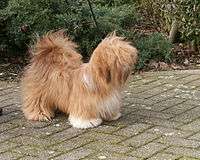
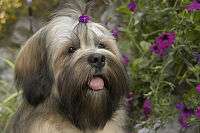
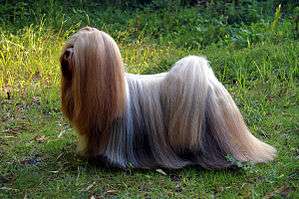
Male Lhasa Apsos should ideally be 10.75 inches (27.3 cm) at the withers and weigh about 14 to 18 pounds (6.4 to 8.2 kg). The females are slightly smaller, and weigh between 12 to 14 pounds (5.4 to 6.4 kg). The breed standard requires dark brown eyes and a black nose, although liver-colored lhasas have a brown nose. The texture of the coat is heavy, straight, hard, neither woolly nor silky, and very dense. They come in a wide variety of colors including black, white, red and gold with various shadings. Lhasas can be with or without dark tips at the ends of ears and beard. The tail should be carried well over the dog's back. The breed standard currently used by the American Kennel Club was approved on July 11, 1978.[3]
Temperament
Having been bred as an indoor monastery sentinel dog by Tibetan Buddhist monks, Lhasa Apsos are alert with a keen sense of hearing. The ideal Lhasa temperament is to be wary of strangers while being loyal to those closest to them. They can be very aggressive to strangers if they're left untrained. They rank 68th (out of 79) in Stanley Coren's The Intelligence of Dogs, being of fair working-obedience intelligence.[4][5]
Lhasa Apsos are independent as well as companion dogs who want to please their owners, yet they may be suspicious toward strangers.[6] Lhasa Apsos often show happiness by rubbing their head on their owners, running and rolling around, or sitting on their owner's feet. While Lhasa Apsos show loyalty to their owners, they will let their masters know when they don't want to do something. They will lie flat without moving, "put on the brakes" and refuse to walk forward, or try to back away. Time and patience will build the trust between the Lhasa and owner.
A Lhasa Apso responds to exercise and discipline with a calm assertive energy. These dogs require early socialization with dogs and other people as puppies and throughout their lives. Because Lhasa Apsos are an independent and intelligent breed, house training puppies requires consistency. They require patience and may be slow to house train, but in return, they can be quite comical, entertaining and caring companions. They aim to please their owners and enjoy training. While their personality belies their size, they need a home that is mindful that there is a small dog in the house to prevent injury. They enjoy vantage points in the house where they can view all that is going on.
The Lhasa Apso is a long-lived breed, with many living in good health into their early 20s.[7] The average age for these dogs is 12–14. There are few health problems specific to the breed. Their vision may deteriorate with age, but they are not sight-oriented dogs and they endure blindness with few noticeable changes in behavior.
History
The Lhasa Apso originated in the area of Tibet over 4,000 years ago as a small breed of mountain wolf.[8] They were domesticated and actively bred perhaps as long ago as 800 BC, which makes the Lhasa Apso one of the oldest recognized breeds in the world. Recent research has shown the Lhasa as one of the breeds most closely related to the ancestral wolf. (Others are Akita, Shiba Inu, Shar-Pei, Chow, Basenji, Alaskan Malamute, Siberian Husky, Saluki, Afghan, Pekingese, Shih Tzu, and Samoyed.)[9]
Referred to in Tibet as Apso Seng Kyi, which can be translated as "Bearded Lion Dog", the Lhasa's primary function was that of a household sentinel, guarding the homes of Tibetan nobility and Buddhist monasteries, particularly in or near the sacred city of Lhasa. The large Tibetan Mastiffs guarded the monasteries' entrances, but the keen hearing and sharp bark of the Lhasa Apso served to warn residents by acting like a burglar alarm if an intruder happened to get past the exterior guards.
It was believed that the bodies of the Lhasa Apsos could be entered by souls of deceased lamas while they awaited rebirth into a new body. Lhasas in Tibet were never sold. The only way a person could get one was as a gift.[9]
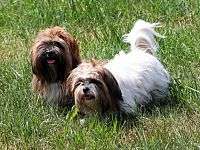
In the early 1900s, a few of the breed were brought by military men returning from the Indian subcontinent to England, where the breed was referred to as "Lhasa Terrier".[10]
The original American pair of Lhasas was a gift from Thubten Gyatso, 13th Dalai Lama to C. Suydam Cutting, arriving in the United States in 1933. Mr. Cutting had traveled in Tibet and met the Dalai Lama there.[11] At this time, there was only one Lhasa Apso registered in England.[12] The breed was at first called the Lhasa Terrier, later the Lhasa Apso. The American Kennel Club officially accepted the breed in 1935 in the Terrier Group, and in 1959 transferred the breed to the Non-Sporting Group.[13] In the UK, they are placed in the Utility Group.
Certain characteristics which are part of the breed type evolved as a result of geographical and climatic environment — the high altitudes, the dry windy climate, the dusty terrain, the short hot summer and the long bitterly cold winter of the Himalaya region. Among these are head features, the coat, eye-fall, the musculation and body structure, the general hardiness and longevity of the breed.[14]
DNA Analysis has identified the Lhasa Apso as one of the 14 most ancient dog breeds, verifying that lap dogs and companion dogs were among the first dogs bred by humans.[15][16]
Today, in the USA, there exists a unique group of Lhasa Apsos known within the fancy as the Gompa dogs. (Gompa is the Tibetan word for a monastery’s main meditation hall.) These Lhasa Apsos are direct descendants of the Lhasa Apsos from the Drepung monastery in Tibet, where, in 1941, Lama Gyen Yeshe was gifted Preserving the Future, Enlisting the Past his first Lhasa Apso by a High Reincarnate Lama. In the 1980s, nine Lhasa Apsos bred by the late Lama Gyen Yeshe or sired by one of his dogs were brought into Canada. Bred together for a number of years, descendants were eventually registered with the United Kennel Club (UKC). In 2000, the remaining descendents entered the United States as part of a successful rescue. Since then, organized efforts have been made to maintain the dogs and preserve the line. The Gompa Lhasa Apso Preservation Program (GLAPP), a 501(c)3 organization, is a small population genetics management program perpetuating the genetic lineage of the Gompa Lhasa Apso. Not having undergone selection to a written standard, this unique gene pool represents the Lhasa Apso as it developed as a landrace. GLAPP’s internal database contains records of all dogs being used to perpetuate this genetic lineage and includes DNA Profiling, DNA Parentage Verification and microchip identification. Dogs born within the Preservation Program continue to be registered with UKC.[17] In August 2011, seventeen dogs from the Gompa Lhasa Apso Preservation Program entered the American Kennel Club (AKC) studbook. The goal of recording recently imported region-of-origin Lhasa Apsos is to increase genetic diversity while maintaining the integrity of the AKC studbook.[18]
Shedding
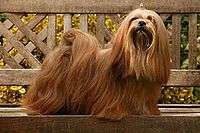
Like most mammals, all dogs slough off dander, or flake dead skin. Since dander and many other allergens become trapped in hair, the susceptibility of allergies acting up is dependent of the amount of hair shed and the weight of the hair. As the amount of hair shed increases, and the weight of the hair decreases, the probability of airborne hair, dander and allergens increases. This will, therefore, increase one's allergies to a particular animal. Lhasas have long, coarse hair, which causes the weight of the hair to be heavy. Due to the long length of hair, lhasa apsos do not shed hair the same way as other breeds. Instead, they shed hair like humans, slowly and continuously, as to keep their hygiene clean and risk of matting and tangling low. The long, heavy hair prevents individual hair strands to become airborne, and decreases the amount of dander in the air as compared to other breeds. People with allergies may co-exist with the low-shedding breeds of dogs, like the Lhasa Apso.
Coming from the extremely cold weather of the Himalayas, the Lhasa has a double coat: an under coat to keep them warm and an outer coat consisting of guard hairs for protection and aiding to keep their coat flat and smooth. The outer coat consisting of the guard hair should be similar to human hair, you should be able to feel individual hair strands when touched. While the under coat is softer and finer, it should lay flat and blend in with the outer coat.
Routine brushing and bathing is necessary, not only to keep up on the slow continuous shedding, but to also remove any dirt and debris that may get caught within the hair strands. A lhasa with a thick coarse outer coat will likely require less grooming than a lhasa with a lot of under coat and soft, less coarse, top coat.
Health
The Lhasa Apso is known to suffer from a few health problems. For example, it is known to suffer from sebaceous adenitis, a hereditary skin disease that occurs primarily in Standard Poodles, but has also been reported in a number of other breeds, including the Lhasa Apso. They are also known to suffer from the genetic disease progressive retinal atrophy (PRA) which can render them blind. Responsible breeders have their breeding dogs checked yearly by a canine ophthalmologist to check that they are not developing the disease, which is heritable in offspring. Lhasa Apsos are also prone to eye diseases, such as cherry eye and keratoconjunctivitis sicca (KCS or dry eye syndrome).[19] A 2004 Kennel Club survey puts the median lifespan of the breed at 14 years 4 months.[20] UK vet clinic data puts the median at 13.0 years.[21]
Whilst regarded by many as a "lap dog", Lhasa Apsos do require daily exercise, by play and walks, to maintain physical health and mental wellbeing.[22]
In pop culture
- The Brazilian comic series Monica's Gang features a green-colored Lhasa Apso named Fluffy which belongs to Jimmy Five.
- In the animated series Spider-Man and his Amazing Friends, Angelica Jones/Firestar owns a Lhasa Apso named Ms. Lion.
- Lhasa Apsos have also appeared in at least two episodes of The Simpsons. In the episode "Three Gays of the Condo", Homer Simpson moves in with a couple of gay men. Homer started to act like a gay man and got a Lhasa Apso. Also, Milhouse Van Houten owns a Lhasa Apso.
- In the television series The L Word, Helena is assured by her wealthy mother that she was going to leave her inheritance to her, not to her Lhasa Apsos.
- Lhasa Apsos are said to bring luck, hence the saying "Lucky Lhasa".[23]
- Singer Arturo Paz owns a Lhasa Apso named Coco.[24]
- Actress/Singer-Songwriter Keke Palmer has a Lhasa Apso named Rust[25]
- A Lhasa Apso is both a major character and a plot device in the 1948 children's novel Daughter of the Mountains by Louise Rankin (ISBN 978-0140363357).
- Singer Gwen Stefani had a Lhasa Apso dog called Lamb/Meggan.
- Reality star Bethenny Frankel has a Lhasa Apso named Cookie, who regularly appears on her show Bethenny Ever After.
- Science fiction author John Scalzi includes a Lhasa Apso named Tuffy in a pivotal role in the The Dog King, the seventh part of his episodic novel The Human Division.
- Writer Kurt Vonnegut lived with a Lhasa Apso named Pumpkin.
- Singer Barbra Streisand owned a Lhasa Apso, and dedicated her performance of "Smile" on the Oprah Winfrey Show to it, after its death. She even dressed up as her beloved pup for her 2013 "Halloween Bash" hosted by Patti LaBelle.
- Avant-garde art collector Peggy Guggenheim loved the Lhasa Apso breed so much, she has a burial site next to her own for her 14 "Beloved Babies" in Venice, Italy.
- Singer-songwriter Criss Starr has a Lhasa Apso named Mozart.
- The Hard Science Fiction Web Comic Freefall (Web Comic) has Winston owning a Lhasa Apso called Beekay.
References
- ↑ Definition of Lhasa apso, EtymologyOnline.com
- ↑ Wehrmann, Stephen (2002). Lhasa Apsos: Everything about Purchase, Care, Nutrition, Behavior, and Training. Barron's Educational Series. ISBN 0-7641-1958-3.
- ↑ Club, American Kennel. "Lhasa Apso Dog Breed Information". Retrieved 27 July 2016.
- ↑ "Dog intelligence rankings". 6abc.com. WPVI-TV. November 12, 2008. Retrieved June 16, 2012.
- ↑ "Ranking of Dogs for Obedience/Working Intelligence by Breed". Archived from the original on 2013-01-02. Retrieved January 13, 2016.
- ↑ "Lhasa Apso Temperament – What's Good About 'Em, What's Bad About 'Em". Your Purebred Puppy. Retrieved January 8, 2013.
- ↑ "Border Collie, Chinese Crested, English Mastiff, Italian Greyhound, Lhasa Apso". Dogs 101. Season 2. Episode 5. October 31, 2009. Event occurs at 3:01. Animal Planet. Retrieved January 27, 2013.
- ↑ "Origins of the Lhasa Apso". Tushita Lhasa Apso. Retrieved January 8, 2013.
- 1 2 "History". Retrieved 27 July 2016.
- ↑ Clark, Anne Rogers; Andrew H. Brace (1995). The International Encyclopedia of Dogs. Howell Book House. p. 294. ISBN 0-87605-624-9.
- ↑ Wehrmann, Stephen (2002). Lhasa Apsos. Barrons Educational Service Publisher. ISBN 0-7641-1958-3.
- ↑ Aldige, Leslie (22 July 1968), "Dog of the Year", New York, pp. 32–34
- ↑ "Lhasa Apso History", American Kennel Club
- ↑ Sefton, Frances. Lhasa Apso Breed Type
- ↑ Ostrander, Elaine A. (September–October 2007). "Genetics and the Shape of Dogs". American Scientist. pp. also see chart page 4. Retrieved January 8, 2013.
- ↑ Search query for Ancient Dog Breeds, Science
- ↑ "Preserving the Future, Enlisting the Past" (PDF). Retrieved February 9, 2016.
- ↑ "Native Stock Committee - ALAC". lhasaapso.org. Retrieved 2016-02-09.
- ↑ Lhasa Apso Health at dog-breeds.in
- ↑ "Individual Breed Results for Purebred Dog Health Survey". Retrieved 26 June 2012.
- ↑ O’Neill, D. G.; Church, D. B.; McGreevy, P. D.; Thomson, P. C.; Brodbelt, D. C. (2013). "Longevity and mortality of owned dogs in England". The Veterinary Journal. 198: 638–43. doi:10.1016/j.tvjl.2013.09.020. PMID 24206631.
- ↑ "Lhasa Apso". dogbreedinfo.com. Retrieved 2016-07-27.
- ↑ Bailey, Mrs. Eric. Origins of the Lhasa Apso
- ↑ Tiger Beat
- ↑ MTV Cribs
External links
- Lhasa Apso at DMOZ
-
 Media related to Lhasa Apso at Wikimedia Commons
Media related to Lhasa Apso at Wikimedia Commons